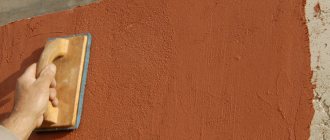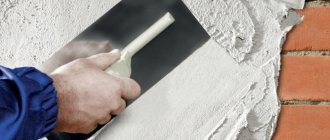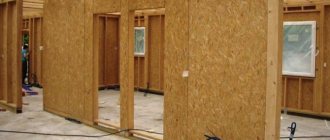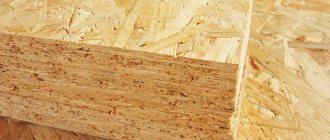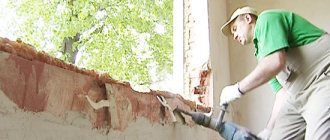Brick walls are considered durable and strong, but due to some negative factors, cracks may form on them.
This deficiency can be easily eliminated if you know in detail the features of the technological process and immediately take action to eliminate the resulting deficiency.
How to properly carry out restoration work and repair cracks in a brick wall of a house, read the article below.
Types of defects
Building brick is a common material used for the construction of internal and external walls. It is considered durable, strong, and lasts for decades.
If cracks appear on brick walls, it means the surface has been exposed to external or internal destructive factors. Therefore, it will be necessary to identify the reason why the chip occurred.
Perhaps somewhere the load on the walls has increased or these are the consequences of man-made circumstances . In any case, you need to carefully examine the entire surface of the wall that is cracked, paying attention to the direction and width of the chip.
Under a strong vertical load, the crack will expand downward, and if the problem is in the foundation (sagging, groundwater has washed away, mistakes were made in construction), then the crack will expand upward. If the material has become unusable, then a fine network of cracks will be located closer to the surface.
Cracks are divided into the following types:
Vertical.- Horizontal.
- Narrow (up to 5 mm).
- Wide (more than 1 cm).
- Superficial.
- Deep.
- Medium (5-10 mm)
- Inclined.
- Direct.
- Closed.
- Through.
- Curvilinear, etc.
The listed types are clearly visible upon visual inspection; they can be located both on the external facade of the building and on the inside of the house. The size of the defect can be easily determined using a construction tape.
Small chips can be quickly fixed with your own hands using sealants , concrete mortar or by injection. For very large gaps, professional intervention and replacement of the damaged area will be required.
Wide cracks with dimensions greater than 1 cm are considered critical defects that require elimination by special repair methods.
Types of cracks
Cracking can occur for various reasons. Some cracks lead to deterioration in appearance, while others are extremely dangerous for homes and can cause negative consequences if they are not eliminated in advance. Vertical, horizontal and diagonal defects indicate the direction of places with increased loads, causing damage to the walls.
Surface cracks are not dangerous. They can only lead to a deterioration in the appearance of the building. When cracking occurs along a layer of plaster, the damage is present only on this coating.
Deep cracks are more dangerous, since for some time they are completely invisible visually, especially on walls that are wallpapered indoors or lined with panels on the street side. In such cases, damage is detected when reaching the surface, leading to its splitting lengthwise. To effectively eliminate them, you have to resort to special methods.
In addition, cracks can be stable or unstable. Damage of the first type appears for various reasons, for example, due to shocks, soil collapse, etc., and their dimensions do not increase in the future. They can be quite large and look scary, but such cracks can be repaired.
It is much more difficult to cope with unstable damage, since their size becomes more significant over time. Initially, they are small and difficult to detect, but often the crack soon increases in size, growing throughout the entire wall and, as a result, can even lead to its collapse. If, a month after sealing with mortar, the damage has become even larger in size, this indicates the presence of unstable cracking.
It is extremely easy to identify such a crack. To do this, you need to take a strip of paper, write the current date on it, and then glue it tightly across the cracking line. With further growth and increase in damage on the wall, the material will rupture. The disadvantage of this method is that it can only be used indoors. In addition to paper, a suitable option for this purpose is to use lumps of alabaster, which must be stuck across the cracks, as well as finishing putty of a thick consistency, which should be used to repair the resulting damage.
If you are afraid of erasing the inscription while the mixture is soft, you can squeeze out the date in it. With regular inspection, you can determine the rate at which cracks are increasing in size. Longitudinal damage is detected in a very simple way when its edges are marked with a pencil with the current date. When cracks expand, it is necessary to take active action, but only after the increase in size has finally stopped. Otherwise, if this process has not yet ended, then some time after the repair, the cracks will reappear.
The magnitude of damage is as follows:
- Small (up to 5 mm).
- Medium (within 5-10 mm).
- Wide (over 1 cm).
The most dangerous are the damages of the last magnitude, because in most cases it will not be possible to completely get rid of them unless the cause that led to the formation of the crack is eliminated.
Note! Cracks wider than 2 cm are considered critical. In such a case, there is a need to additionally strengthen their edges and strengthen the brick building, and areas that are susceptible to destruction require dismantling work.
Causes of cracks in masonry
Defects that appear on brick walls are classified into types depending on the specific reasons that contributed to the cracking of the surface. The following types of cracks occur, depending on the factors influencing them:
- Constructive. Influencing factor:
- incorrect calculation of foundation dimensions (depth);
- increased load on the walls;
- broken construction technology;
- unsuitable brand of solution;
- lack of reinforcement.
Shrinkable. Main factor:- a nearby pit with a building;
- construction of buildings on soils classified as bulk.
- Deformation. Main factor:
- man-made causes;
- incorrect selection of materials for laying.
- Worn out. The main reason: the service life of the brick has expired.
- Temperature. Factors:
- unprotected, constantly freezing foundation;
- constant temperature changes indoors and outdoors.
The method of eliminating the defect directly depends on the factor series, which must be established independently or with the assistance of a qualified specialist. There can be many reasons for the appearance of faults.
Factors that cause the formation of cracks in brick walls are also:
- Broken ligament between bricks (or lack thereof). A vertical gap appears, which will require a tie with an armored belt.
- Mistakes when laying a house (failure to take into account the level of freezing and type of soil, the use of silicate materials (blocks), the use of poor-quality fill. Cracks in the corners of the building quickly expand. In this case, only deep strengthening of the foundation will help, and only then - repairing the wall.
- Lack of consideration of soil during construction. Nearby drains, nearby highways, and groundwater can damage walls over the entire surface. Here, before repairing the walls, it will be necessary to strengthen the base at the level of concrete pouring.
- Shrinkage of the building in the first year of construction. Initially, thin cracks appear, which can then expand. But, if they are repaired using cosmetic repairs, the defect will be eliminated.
- Load from top coverings, floors, balconies and other load-bearing structures. Here you will need professional construction assistance with a reinforced screed in order to redistribute the weight on the problem area of the wall.
When cracks are identified on a brick wall and the cause of their formation is established, the factor is first eliminated, and only then repairs begin. This rule is observed both for repairing the facade of the building and indoors.
How to change bricks in a masonry?
First, the cracked bricks must be removed from the wall. For this:
- Frequently spaced holes are drilled into the mortar around the brick.
- Then they take chisels and destroy the remaining cement.
New bricks should be soaked in a bucket of water 1 hour before laying.
Before starting laying, the perimeter of the disassembled hole is cleared of the remnants of the old mortar. The row is moistened and the prepared masonry mortar is applied. Masonry mass is also applied on top of the brick and on the sides. The brick is inserted into the right place. If necessary, add mortar to the seams.
Test for determining the dynamics of destruction
Before starting the restoration process, make sure that the crack does not expand. The readiness of the wall for repair is determined by a construction beacon installed on the wall , the readings of which are recorded within 2 weeks.
Small deviations may indicate that the main cause of the formation of cracks has not been eliminated, so it will be necessary to strengthen the base again, check the efficiency of groundwater drainage and the load on the wall.
In addition to beacons, there are tests with cement mortar or a strip of paper .
For the first option, take a little liquid cement and seal the gap, which is left to dry. Then they look to see whether the crack has healed or whether the defect remains unchanged. The test with a strip of paper is as follows: a little cement is placed in the gap, and when the solution has dried a little, a strip of paper of arbitrary length is placed on it, the width of which should be 1-2 cm larger than the defect.
Then, as the solution dries, look at the strip . If it stays in place, does not tear, does not heal, and the width of the crack does not increase, then you can begin repairing the surface.
Changing the position of the strip or its damage will indicate that a good screed will be needed. And only after the surface has completely dried can you apply cosmetics. If the strip of paper changes its position and retracts, it will need screeding, drying, and then a finishing coat.
If desired, you can conduct a professional engineering examination . The engineer will be able to accurately determine the cause of defects on the brick wall, and will perform all the test work himself.
Experts most often control surface tensile tests using plaster or plate beacons with a scale. The paper test is carried out at home.
If the crack is through
In an effort to eliminate the defect in a situation with a through crack, strengthen the damaged wall:
- first clean the crack area from dirt, dust particles, and any old coating;
- moisten the gap with water, wait until the moisture dries;
- fill the crack with crushed stone and cement mortar;
- fix the gap with steel plates, nailing them with dowels;
- carry out finishing work to hide the damage.
To prevent the crack from opening, drive steel staples into the sides of the crack and then secure them with bolts. Be sure to fill each hole made with cement before fixing it.
Sealing options
Brick walls can be sealed in different ways, which have more advantages than disadvantages. The choice of option depends on the type of crack, area of distribution and its depth. In some cases, a combined sealing option is used (2-3 options simultaneously, applied to the surface one by one).
Injection
This method consists of eliminating the seal by sealing existing leaks and restoring the load-bearing capacity of the brick. This method is especially recommended after eliminating accidents associated with leaks (pipe burst, precipitation) that caused the crack to appear.
The advantage of this method is the ability to quickly restore a brick wall, without the need for dismantling and re-laying. But injection must be carried out by qualified workers using special equipment. They also select the necessary material.
For the chosen method, different materials are used:
- microcements;
- polyurethane, one-component, silicate compounds;
- epoxy resins;
- methyl acrylate gels.
The injection method resembles drilling, and large cracks must be opened. For drilling, points (holes) are marked, which are placed in a checkerboard pattern, after blowing them with compressed air. The repair composition is pumped with a construction tool (pump, gravity), which is filled into the existing pores through a special hose.
The only downside of this method is that you cannot do it yourself without special qualifications and equipment, and hiring a specialist will require additional financial costs.
Injection allows you to penetrate deeply into the damaged area and completely fill the crack and damaged parts of the wall with a repair compound.
Concrete mortar
Cement mortar with the addition of fine crushed stone is suitable for sealing the surface of a brick wall. This is a popular and quick type of repair, and you can do it yourself.
Many specialists, just in case, to prevent the gap from widening, make a screed using T-shaped anchors on both sides. The anchors are tied together with metal strips.
Polymers or milk of lime are added to the finished repair mortar to increase strength. Cement, sand, water (cement composition) are construction classics. If you add crushed stone to it, you get a concrete solution.
The proportion of the concrete composition for repair is 1 (cement): 3 (river sand): 5 (crushed stone up to 15 mm) . Water is added to the finished mixture gradually, the composition is mixed until creamy and applied to the wall using a trowel and spatula.
For repair work, you need to use a small amount of the composition, so it needs to be done in small quantities, as it hardens quickly (in 1-1.5 hours).
Sealant
The substance of this plan helps prevent moisture from entering.
The sealant is made from polymers; it seals seams well, adheres to any stone surfaces and dries quickly. This material penetrates deeply into the pores, performs a protective function and does not change the appearance of the wall.
There are different types of sealants. There are single-component and multi-component materials that are characterized by varying degrees of hardening and elasticity. Also, sealants are silicone, acrylic, mixed, bitumen, polyurethane. An example of a polyurethane sealant is foam concrete (spray foam).
When choosing a sealant for repairing brickwork, you need to pay attention to the fact that the packaging indicates that the material must be moisture resistant, withstand temperature changes and exposure to sunlight. This material is considered fast and effective, and this is its main advantage. The only downside is its cost .
Experts recommend choosing a breathable sealant for brick walls that will resist peeling.
A crack has appeared in the wall of a brick house, what to do: 3 options
The technology by which it is best to seal the gap is chosen based on its size and location. If it is inside a building, you can use gypsum putty. Outside the house or in rooms with high humidity, it is better to apply moisture-resistant material: silicone sealants, polyurethane foam, cement mortar.
If the split is dangerous - it is vertical, wide and growing quickly, you may not be able to cope on your own. Especially when it comes to supporting structures. To do the job well, you will need the help of builders. You may have to adjust the foundation and install supports to the load-bearing walls. The easiest and fastest way to eliminate shrinkage, narrow cracks up to 5 mm.
Instagram @alignfoundation
Instagram @vysotnye_raboty
Sealing cracks in brick walls with cement mortar
In addition to cement mortar, you will need a tool to clean the gap and widen it a little (this is convenient to do with a scarpel), a hammer and reinforcing tape.
Sequencing:
- cleaning the surface from dirt and previous finishing;
- moistening the problem area to create better adhesion to the putty;
- applying cement or gypsum mortar (depending on the location of the damage). Proportions 1:2. It is recommended to use Portland cement M400 or M500;
- laying reinforced tape and cementing it.
Microscopic cobwebs up to 1 mm can be sealed with epoxy resin. The composition should penetrate the damaged masonry to the maximum depth. Sometimes a little glue is added to it to improve the plasticity of the material.
Correction of cracks 6-10 mm
In this case, follow the same instructions, but add a little fine sand to the cement mixture. Instead of a solution, polyurethane foam is also used.
- She is blown into the rift with a pistol. There is no need to fill the gap completely, since the foam expands as it hardens.
- After a few hours, cut off what remains above the surface with a sharp knife or spatula. This should not be done flush with the wall, but to a depth of 2-3 mm.
- Polyurethane foam is destroyed by ultraviolet radiation, so it needs to be primed and plastered.
Such a defect is considered small and silicone sealants are also used to eliminate it. They are not afraid of temperature changes and high humidity. Remove excess with a spatula until it hardens. The disadvantage of the material is that it cannot be finished.
Some instructions advise laying a metal mesh with 5*5 mm cells over the cemented split. Holes are made along the damage for dowels and the mesh is secured with screws. Then it is primed and plastered.
Sealing openings larger than 1 cm
Damage greater than 10 mm is considered serious and plaster alone is not enough.
Sequencing:
- the damaged part of the wall must be dismantled, always starting from the top row;
- the surface is well cleaned;
- then the masonry is reassembled using the “brick castle” method;
- metal strips and reinforcement are added to it to bridge the split.
If it is impossible to disassemble damaged bricks, use another technology.
- The fracture site is cleaned with a scarpel or brush and moistened.
- Then the cement-sand mixture is poured into it to the full depth.
- Several T-shaped anchors are installed along the entire fault and secured with dowels.
The third method is to use polyurethane foam. The algorithm is similar to that described above: cleaning the surface, blowing foam (only half of the gap), cutting off the excess, priming and plastering.
A crack in the load-bearing wall of a brick house can be eliminated using the methods given above if it does not increase. If the test with beacons shows the progression of the defect, first correct the violations at the source of the problem - the foundation, extensions, floors.
The through gap is sealed with cement plaster. To bridge a large fault, small fragments of brick or medium-sized crushed stone are added to it. Such a surface must subsequently be additionally secured. Reinforcing mesh will not be enough for this.
Instagram @soul.of.phoenix
Instagram @veronica_bailey_photographer
What is the best way to cover it?
Choosing the best option for restoration work depends on:
- crack sizes,
- its depths
- surface damage area,
- the main cause of occurrence,
- choice of material by the master.
For example, if the defect arose due to an incorrectly poured foundation, then in this case it is best to start by strengthening the concrete belt of the base of the building.
To do this, a trench is dug around the perimeter of the house, which will be much deeper in depth than the foundation. The issue of soils, groundwater drainage is resolved, backfilling is done with bulk and then the concrete solution is poured in accordance with the technology.
If the cracks are only superficial, not deep, and there is no need to strengthen the foundation of the building, then sealants or concrete mortar can be used to seal them. In difficult cases, concrete screed and injection are used.
Strengthening brick walls - tips
In order for a wall with cracks to be strengthened reliably, it is best to strengthen it from the inside of the building - any master will confirm this.
If after repairing a brick wall there is no result, the best option is to carry out a partial re-laying.
How is strengthening carried out from the inside?
- Cracks are sealed;
- Locks or metal profiles are placed on them;
- The lock is secured to the wall with anchors; the gap must be covered across with them - due to this, it will not increase in the future;
- Metal brackets can help with repairs - their ends should extend slightly into the wall to a depth of approximately 50% of the wall thickness. Holes for staples are made in advance;
- Such a wall can be fully used a day after repair. However, it is better to refrain from heavy loads - the structure will gain full strength only after 30 days.
If the cause of cracks is an improperly poured foundation, the foundation should be strengthened - a concrete auxiliary belt will help with this.
It's done like this:
- You need to dig a trench around the entire perimeter of the house. The recommended depth is greater than the depth of the foundation;
- An auxiliary belt is laid in the resulting trench;
- To prevent cracks in the masonry in the future, the foundation must be poured strictly according to technology - otherwise the work will not bring the expected result.
Cracks form for various reasons, including due to poor-quality foundation
Consumables and tools
To perform repair and restoration work on a brick surface, you may need:
- container for mixing concrete mortar, shovel;
- trowels, spatulas;
beacons, protractor, construction centimeter;- brush, hammer, dowels, anchor bolts;
- sealant (foam);
- cement, sand, gravel, running water (or ready-made dry concrete mixture);
- sheets of reinforcement and rolled metal;
- sledgehammer, crowbar, pickaxe, scarpel;
- drill, pump;
- rags, gloves, work clothes;
- ladder.
All materials and tools (their quantity) are selected depending on the magnitude of the damage and the chosen sealing option. For concrete mortar, it is best to use cement grade M 400.
Many craftsmen advise preventing further opening of the crack by hammering steel staples into both sides of the crack. The ends of the brackets must be bent towards the wall and secured with bolts.
How to seal cracks and cracks
The material for sealing cracks must be selected depending on the size and types of the defects themselves. It is necessary to select moisture-resistant compounds for future sealing.
What is the best way to seal cracks:
- If these are minor defects up to 5 millimeters in size, then a simple cement mortar is used. In the case where the cracks are completely microscopic, 1-2 millimeters in size, use epoxy resin. Apply to a spatula and rub into the crack.
Sealing cracks with mortar - Provided that the defects are of medium size, up to a centimeter, cement compounds and sand can be used. There should be two or three times more sand when mixing. It is worth adding water to make the consistency more plastic.
- Polyurethane foam – for large cracks. The material does not like the sun very much, so it is worth making sure that there is no direct contact with the sun's rays.
- Cement grade M400 with special polymer compositions. It creates maximum protection and fixation for cracks of any size. But the price is high. More often they cover cracks in large private buildings or src=»https://otremontirovat25.ru/wp-content/uploads/2019/12/marki-tsementa.jpg» class=»aligncenter» width=»650″ height=»350 ″[/img] Cement brands
- Sealants with silicone - for finishing any problem area on brickwork. Very plastic material, has a long shelf life. It is easy to cope with temperature changes and humidity. Apply with a mounting gun. The only negative is the high price.
Using sealant - If the defects touch the outer parts of the wall, then you can use solutions with the addition of brick chips.
Repair technology
inside or outside the building, applies
- The repair site must be cleared of contamination (debris, dust).
- Then pour the surface with clean water and leave until dry.
- Expand the crack to lay the mortar or, conversely, screed it with a metal profile and anchors.
- Treat the crack with concrete mortar or apply sealant. Leave until completely dry.
- Clean and remove the remaining mortar, cut off excess pieces of polyurethane foam with a construction knife.
- You can apply reinforced fly, having previously strengthened it with dowels on the surface. Then apply cement mortar.
- After complete drying, they begin to finish.
If the crack needs injection, then after thoroughly cleaning and washing the crack, use a construction pump (gun, syringe) to fill the empty space on the wall.
Seal a crack in a brick wall with your own hands, video instructions:
How to repair a wide crack
So, let's find out how to repair a crack in a brick wall of a house, if it is not too big. Defects wider than 10.1 mm, as already mentioned, can only be eliminated by dismantling the masonry. This procedure must be performed as carefully as possible. Begin dismantling the masonry exclusively from the top row. You cannot knock bricks out of the wall.
Replacement with new brickwork is carried out according to the “lock” principle with bandaging of the seams. In this case, reinforcing metal plates are used. The latter should cover the gap completely. Instead of plates, you can use regular thick reinforcement.
What not to do?
During the process of repairing cracks in brick walls, errors may appear :
- Failure to eliminate the main reason that caused the defects. If the cause is problems with the foundation or loads, then surface repairs will only give a short-term effect.
- Uneven masonry during deep wall repairs and poor binding of bricks. Deviation in level (vertical or horizontal) can form a bulge that cannot be eliminated with plaster. Vertical seams should not coincide with adjacent ones.
- Sealing on an uncleaned surface. Dirt, debris, mortar and brick residues that are not removed before starting restoration work can cause poor adhesion to the new mortar or sealant. This will lead to ineffective ongoing repairs.
- Inaccuracy when filling the pores with a solution of concrete or sealant. If the solution has not completely filled the space, then there is a possibility that under the influence of atmospheric air pressure the crack will begin to diverge again.
- Refusal of the screed. In case of serious damage, it is better to tighten the edges of the crack. This will help prevent further destruction of the masonry, and will provide a good stable base for filling the pores of the wall.
Failure to comply with the temperature conditions when performing repair work can also be considered a mistake. Normally, it is believed that the entire process with a brick wall should be carried out at a temperature above + 5°C.
Foundation deficiencies and their elimination
Often, cracks in brick walls appear due to certain problems with the foundation.
In such a situation, the most correct choice is to strengthen the foundation, even if it is faced with stone. Due to this, the subsequent formation of cracks will stop, as well as the spreading of existing defects.
This work is done like this:
- Dig a trench along the area where the crack has formed. The thickness of the trench should be no more than the monolithic base. The optimal depth is just below the bottom edge;
- The crack site is cleaned, all elements that do not adhere well are removed, the cement mortar is scraped off and slightly enlarged;
- Then the area is drilled horizontally and vertically for reinforcement;
- Anchors are woven together with reinforcement and welded. The distance between the reinforcement varies between 60 and 100 cm - here everything is determined by the size of the crack. The resulting structure will be a reliable frame that will connect the house and the new, already reinforced foundation;
- Wooden formwork is being installed;
- Concrete is poured;
- Everything is left to dry until completely dry - about a month;
- A blind area is created;
- Using paper beacons, they check whether the cracking process has been stopped.
When the foundation is restored, you can begin to repair the walls themselves:
- Cement mortar is used to seal damage up to 5 mm. The edges must be trimmed, cleaned, wet - so that good adhesion is obtained with the solution;
- If the crack size is more than 10 mm, sealing is done with sand and cement. Recommended proportions are 3 to 1.
A convenient tool for cleaning cracks in walls is a spray bottle.
When the gaps in brick walls are large, radical measures cannot be avoided:
- The top brickwork is dismantled and damaged elements are removed. Laying of new bricks is carried out with a lock, everything is strengthened with metal rods, you can also use metal strips or corners here;
- If breaks in the masonry are observed, metal strips are used. The ends of these elements are bent directly into the masonry, pressed as much as possible - with screws, anchors, bolts.
It happens that the described methods cannot be used. Then crushed stone is poured into the gap along with cement. T-shaped anchors are driven in on both sides of the crack - it is worth retreating 0.25 m from the defect. The elements are connected with metal strips and a decent result is obtained.
- If you have to work with deep cracks that cannot be repaired with cement, it is recommended to fill the defect by injecting mortar. To do this, create holes (diameter 25 mm), the step along the perimeter of the gap is 20 cm or more. A tube with a solution is inserted into the hole, and a sealant is pumped into the gap through it using a pump (if there is no pump, a vacuum syringe will help). The task is simple - you need to fill the voids.
When the cracks in brick walls are very large (for example, the masonry is cracked through), repair work is usually carried out both from the inside and from the outside.
Master in progress:
- Cleans the defect area and processes its edges;
- The crack needs to be thoroughly moistened, then cement and crushed stone must be poured into it;
- If necessary, steel plates are installed - they are secured with anchors and dowels;
- After drying, the wall is sealed with plaster (you can choose another cladding - it all depends on the specific area).
Renovation work in progress
Cost of repair work in the Russian Federation
Repair of cracks in brickwork in the Russian Federation depends on the region. You can present it in the form of a table:
| City (region) | Average cost of repairs (RUB/m2) |
| Moscow | 800 |
| Novosibirsk | 600 |
| Krasnodar | 450 |
| Ekaterinburg | 500 |
| Khabarovsk | 400 |
The indicated cost includes repair work to restore:
- brick walls;
- masonry surfaces in separate places;
- cracks in the masonry.
The price may differ from the indicated one if the specialist is very highly qualified and offers sealing with his own materials. The cost of professional services from construction companies is much higher than hiring individual specialists offering their services as a contract.
If you are interested in the issue of repair and restoration of brickwork, take a look at this section.





